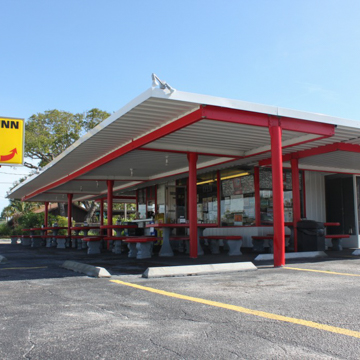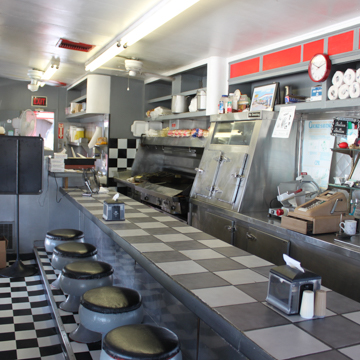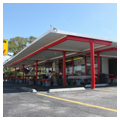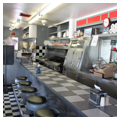The Burger Inn in Melbourne was founded in 1951 as a structurally transparent, automobile-oriented roadside stand. The restaurant preceded by just two years the creation of the Insta-Burger King, later simply Burger King, in Jacksonville, which marked the beginning of one of the most storied chains in roadside burger production. The Burger Inn is favorably located just under thirty miles from Deseret Ranches, founded in the heart of the burgeoning Florida cattle country in 1949 by the Church of Jesus Christ of Latter-day Saints. That beef ranch quickly grew to be one of the largest in the United States.
Unlike the slightly later Burger King and its larger competitor, McDonalds, the Burger Inn had more localized ambitions to attract customers traveling north-south on the Dixie Highway (this stretch later became U.S. Route 1), which had been constructed between 1915 and 1927 by Carl Fisher and connects Miami to the urban center of American beef, Chicago. And like its more famous international cousin, McDonalds, the Burger Inn used architectural elements as part of its branding. Round red columns support the bright yellow electrified sign placed perpendicular to the Dixie Highway on the west side of the structure. Similar red columns and exposed red and red-trimmed steel beams support a deep horizontal shade structure that covers outdoor tables and benches, a walk-up window, and the entrance to a narrow, enclosed counter area with stools. The no-nonsense architectural signature seems to draw inspiration as much from the post–World War II rectilinear designs of Paul Rudolph and the Sarasota School as from the California Case Study houses, including those by Richard Neutra and Charles and Ray Eames. There is little hint of the more dynamic and expressive strain of midcentury modern design known as MiMo that would characterize, for example, the Fontainebleau Hotel by Morris Lapidus in Miami Beach just three years later.
Four layers of dining experience are found at the Burger Inn. Rarely found all together in one restaurant, these elements define expectations of American roadside dining in the postwar period, just before drive-through fast-food consumption would take hold. The outermost layer, closest to the road, was the parking lot where food could be consumed in the patrons’ automobiles. The next layer included rounded concrete tables and fixed benches nestled under the large overhang where patrons could leave their cars and eat outside but under cover. The tables, parked cars, and travelers taking food out could take advantage of the walk-up window located under the large overhang. Finally, for those who wish to eat inside, there were about a half-dozen fixed stools at a counter within a very tight interior space with room for just one person to walk behind the stools. The contrast between the intimacy of this enclosed space and the expanse of the open road of Dixie Highway as it winds north through Florida’s cattle country marks an archetypal moment in midcentury roadside architecture of the state.
References
Hess, Alan. “The Origins of McDonald’s Golden Arches.” Journal of the Society of Architectural Historians45, no. 1 (March 1986): 60–67.
Jakle, John A., and Keith A. Sculle. Fast Food: Roadside Restaurants in the Automobile Age.Baltimore: Johns Hopkins University Press, 1999.
Jakle, John A., and Keith A. Sculle. Remembering Roadside America: Preserving the Recent Past as Landscape and Place. Knoxville: University of Tennessee Press, 2011.
Lorusso, Lesa. “American Architecture Styles: Midcentury Modern.” Florida Historical Society(October 1, 2012).









